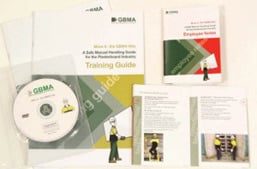
Recently, I was talking to a safety consultant who told me about a business he visited a while ago that had staff handling pieces of wood with multiple nails sticking...
 When it comes to writing or talking about safety, safety leaders often assume that they know what techniques to use to influence and engage others on safety.
When it comes to writing or talking about safety, safety leaders often assume that they know what techniques to use to influence and engage others on safety.
They often start their talk with a chart showing injuries going upwards, talk about the consequences and then talk some more about what needs to be done.
A month later when nothing changes, they complain that no-one takes safety seriously and feel a bit annoyed that no-one listened to them.
So what went wrong?
You've probably worked out that humans are pretty complex creatures. Despite our best intentions, they seem adept at ignoring information that's for their own good (just take children?).
How we commnuicate about safety influences whether or not people will accept or reject our safety messages.
If you want to be a highly successful safety leader, then you need to know what switches people off from your safety messages.
Here are the 5 signs that actually repel people from safety communication:
1. It's not about them - Self-interest is one of the biggest human motivators of all time. People love hearing about themselves. If you are writing or talking to people about safety, make sure you never word the safety information so that it sound like it's about you. If your audience sniffs out that you're just talking about safety to meet compliance obligations, then they will take it as seriously as you do. In other words, not one bit. Personalise the information. Make sure you use the words "you" and "your" (also include "we", so that you work as a team, but "you" for any individual actions required). Let them know that they are important and that you care about their lives, rather than coming from the purely self-serving perspective that you just want to avoid costly injuries and legal ramifications.
2. It looks and even sounds boring - Safety professionals think a chart of rising safety injuries is enough to compel people to change. It isn't. Nor is providing lots of written information and expecting people to wade through it. People are time-poor. Make your writing easy to read and even look approachable by including dot points and summary information. Write compelling headlines. Include visuals that clearly show what it is you are talking about. Avoid complicated charts and data. Consider infographics that quickly relay information.
3. You didn't include them - This is a common mistake. Safety leaders tell people what they think they should know. But what safety leaders need to uncover first, are actually the gaps in people's knowledge. What is it that people don't know? Provide information that gets people thinking, rather than coming from the perspective of "What information do I need to tell people?" In meetings, ask questions about the knowledge gap people have about the topic to encourage curiosity. Doing a little bit of research first, to discover what people know and don't know about a topic, is a great way to ensure that your talk is more personalised and relevant to your audience. Often, safety leaders can ramble on too much about information that people understand causing them to switch off. Meanwhile, the real issue has been missed.
4. They've got other things on their mind - Our brains are marvellous at screening out information that we don't need to know about. We only notice information that is relevant to what is on our mind at the time. For example, if your child is eyesight issues, you will notice information about helping children with poor eyesight. However, if the safety leader wants to talk about ladder safety, when your brain is on the look out for information on eyesight, guess what happens? You ignore the information on ladders. It's not relevant to you. This means that to get everyone's attention, you need to learn how to make it interesting. You've got to hit emotional buttons. This is too big a topic to discuss here, but just blurting out safety information with no intent to make it compelling is a recipe for disaster. Literally.
5. You didn't follow up - In addition to telling people what you want them to do, you need to let them have the ability to get back to you about how it is or is not working. Communication needs to be two-way. Empower your employees by encouraging them to inform you if a process needs to be fixed. Regularly get in touch with everyone to find out how things are progressing. For people to believe what you say, they need to see evidence that you are sincere in your desire for a safe workplace. Just by following up how safety processes are going, they will begin to feel that they can trust and believe you. Over time, this will make it easier for you to change behaviour and get traction with your communication.
Clear and consistent safety communication is one of the most important things a company can do to keep its workers safe. Too often, people approach safety communication as just normal run-of-the-mill information. But it's far more important than that.
How can you start approaching your safety communication differently? Let me know by commenting below. I'd love to hear your thoughts.
Photo credit: By Danilo Rizutti at Freedigitalphotos.net

Recently, I was talking to a safety consultant who told me about a business he visited a while ago that had staff handling pieces of wood with multiple nails sticking...
